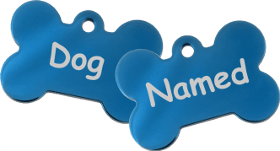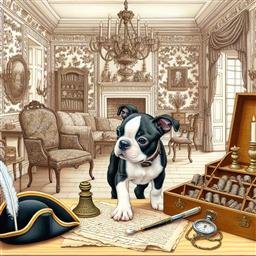1770s Dog Names - Page 3
Updated: June 22, 2024
Welcome to a unique compilation of monikers inspired by the rich and vibrant era of the 1770s. This was a time of significant change across the globe, from the American Revolution to the advent of the Industrial Revolution. It was a period full of character, strength, and resilience, traits that make for a perfect namesake for your beloved canine companion.
We have gathered a collection of names deeply rooted in the culture, literature, and notable figures of this distinctive period. Whether you're a history aficionado or just looking for a name with a touch of historical charm and significance, this assemblage is sure to provide a wealth of inspiration. These names, influenced by the 1770s, offer that classic, timeless feel that never goes out of style.
So, get ready to step back in time and explore this diverse collection. There's something for every breed, personality, and style. From names inspired by great thinkers and revolutionaries to titles drawn from popular literature of the time, you'll find a wide array of unique and meaningful names for your four-legged friend.
| Name | Reason to Choose |
|---|---|
| Hume | In honor of David Hume, an influential philosopher and historian of this era |
| Inglewood | A popular English surname during the 1770s |
| Jarvis | Chosen due to its popularity in the 18th century |
| Jasper | Popular name in the 18th century |
| Jefferson | Thomas Jefferson was a prominent figure during this time |
| Keats | Named after the famous poet John Keats, who wrote in the late 18th century |
| Kepler | Johannes Kepler, the mathematician and astronomer, gives this name historical significance |
| Kingsley | Reflects the monarchical influence of the era |
| Kingston | Represents the capital of Jamaica, a British colony in the 1770s |
| Kipling | Inspired by the works of Rudyard Kipling |
| Lafayette | Marquis de Lafayette was a key figure in the American Revolution |
| Leopold | The name of many European royals at that time |
| Lexington | Inspired by the Battle of Lexington, a key event in the American Revolution |
| Liszt | An homage to the famous composer |
| Locke | This name honors John Locke, a leading philosopher of the Enlightenment |
| Loyalist | Represents those who remained loyal to the British crown during the American Revolution |
| Marlowe | Named after Christopher Marlowe, a contemporary of Shakespeare whose works were still performed in the 18th century |
| Merrill | Popular name in the 18th century |
| Michelangelo | Named after the Renaissance artist, whose works were celebrated in this era |
| Milton | Chosen in honor of the poet John Milton |
| Monarch | Monarchy was a common form of government in the 1770s |
| Montague | Inspired by the characters of Shakespeare's 'Romeo and Juliet' |
| Mozart | A fitting name for a musical dog, after the composer Wolfgang Amadeus Mozart |
| Musketeer | Named after the military rank prevalent during the 1770s |
| Nelson | Named after Admiral Nelson, a naval hero |
| Neville | Reflects the British influence of the period |
| Newton | In honor of Sir Isaac Newton, whose scientific discoveries were still highly influential in the 1770s |
| Orion | Reflects the interest in astronomy during the Enlightenment |
| Orwell | Chosen in honor of the author George Orwell |
| Oscar | Popular in the 1770s, perhaps due to the influence of Irish culture |
|
Suggest:
|
Submitted!
|
| 1 2 3 4 5 | |
1770s Fashion Inspired
| Name | Description |
|---|---|
| Bodice | Inspired by the fitted upper garment for women in the 1770s |
| Breeches | Inspired by the short trousers worn by men in the 18th century |
| Brocade | This name is derived from the intricate fabric often used in 18th century fashion |
| Buckle | A nod to the shoe buckles commonly worn in the 1770s |
| Chintz | Named after the printed cotton fabric popular in the late 18th century |
| Coif | A nod to the close-fitting cap worn by women in the 1770s |
| Corset | A tribute to the essential undergarment for women in the 1770s |
| Cravat | A nod to the neckwear of choice for gentlemen in the 1770s |
| Cuff | Inspired by the decorative cuffs on men's coats in the 1770s |
| Garter | Named after the band used to hold up stockings in the 1770s |
| Hoop | A tribute to the hooped skirts that were popular in the 1770s |
| Lace | Inspired by the delicate and decorative material common in 18th century attire |
| Linen | A tribute to the common fabric used in 1770s clothing |
| Muslin | Inspired by the lightweight cotton fabric popular in 18th century fashion |
| Paisley | Named after the intricate pattern popular in the late 18th century |
| Petticoat | Named after the undergarment commonly worn by women in the 1770s |
| Plume | This name is derived from the ornamental feathers often used in 1770s fashion |
| Ribbon | Named after the decorative fabric strips common in 1770s attire |
| Ruffle | Inspired by the frilly ruffles often used in 1770s clothing |
| Satin | Inspired by the glossy fabric prevalent in 18th century fashion |
| Silk | This name references the luxurious fabrics popular in 1770s fashion |
| Stocking | A nod to the hosiery worn by both men and women in the 1770s |
| Taffeta | A nod to the crisp, smooth fabric used in 18th century fashion |
| Tricorn | This name is derived from the three-cornered hat often worn in the 18th century |
| Velvet | This name references the plush fabric often used in 18th century clothing |
|
Suggest:
|
Submitted!
|
1770s Musical Terms
| Name | Description |
|---|---|
| Allegro | In the 1770s, Allegro was a common term in sheet music, indicating a fast and lively tempo. It would make a lively name for a dog |
| Andante | It's a musical term from the 1770s meaning moderately slow tempo, a fitting name for a relaxed and easy-going dog |
| Baroque | This term refers to a period of musical history. It would make a classic name for a dog |
| Cadenza | A term for a virtuoso solo passage inserted into a movement in a concerto, making it a stylish name for a dog |
| Cantabile | It's a musical term meaning in a singing style. A fitting name for a melodious dog |
| Capriccio | In the 1770s, this term referred to a lively piece of music. It would make a spirited name for a dog |
| Chaconne | A musical form popular in the 1770s, it would make a distinctive name for a dog |
| Crescendo | A term that refers to a gradual increase in loudness in a piece of music. It would make a good name for a dog with a loud bark |
| Divertimento | In the 1770s, this term referred to a light and entertaining musical composition. It could be a fun name for a playful dog |
| Etude | This term refers to a piece of music designed to provide practice. It could be a unique name for a disciplined dog |
| Fugue | This term from the 1770s refers to a complex musical form. It could be a unique name for a dog |
| Intermezzo | This term refers to a composition which fits between other musical or dramatic entities, such as acts of a play or movements of a larger musical work. It would be a unique name for a dog |
| Largo | A musical term meaning slow and broad, it would make a good name for a large and slow moving dog |
| Legato | A term used to denote smooth and connected notes, it would make a harmonious name for a smooth coated dog |
| Minuet | This term refers to a dance of French origin common in the 1770s. It can be a graceful name for a dog |
| Nocturne | A term for a musical composition suggestive of night, it would make a fitting name for a black or dark-colored dog |
| Prelude | A term for a short piece of music, it could be an adorable name for a small dog |
| Rhapsody | This term refers to a free instrumental composition in one extended movement, typically one that is emotional or exuberant. It could be a good name for an emotional dog |
| Scherzo | A term for a vigorous, light, or playful composition, it would make a playful name for a dog |
| Serenade | In the 1770s, this term referred to a musical composition in someone's honor. It would make a sweet name for a dog |
| Sonata | A term for a type of musical composition in the 1770s, it could be an elegant name for a dog |
| Tempo | This term refers to the speed at which a piece of music is played. It would make a fitting name for a fast or energetic dog |
| Toccata | This term refers to a musical composition for a keyboard instrument designed to exhibit the performer's touch and technique. It would be a unique name for a dog |
| Virtuoso | A term used to describe a highly skilled musical performer, perfect for a dog with lots of tricks |
| Vivace | A term used to indicate a very fast tempo. It could be a great name for a fast and energetic dog |
|
Suggest:
|
Submitted!
|
1770s Place Names
| Name | Description |
|---|---|
| Bennington | This represents the Battle of Bennington in the Revolutionary War |
| Boston | Named after the city famous for its role in the American Revolution |
| Brandywine | In honor of the Battle of Brandywine, a major battle in the Revolutionary War |
| Bunker | For Bunker Hill, the site of a major battle in the early stages of the Revolutionary War |
| Camden | In honor of the Battle of Camden, a significant battle in the Southern theater of the Revolutionary War |
| Charleston | This represents the significant port city of Charleston in South Carolina |
| Chesapeake | This represents the Chesapeake Bay, a strategic location during the Revolutionary War |
| Concord | This is the site of the first day of battle in the American Revolutionary War |
| Cowpens | Named after the Battle of Cowpens, a decisive victory in the Revolutionary War |
| Germantown | In honor of the Battle of Germantown, a significant battle in the Revolutionary War |
| Guilford | A tribute to the Battle of Guilford Court House in the Revolutionary War |
| Hudson | A significant river during the American Revolution |
| Kingsmountain | Named after the Battle of Kings Mountain, a decisive victory in the Revolutionary War |
| Lexington | The Battle of Lexington was a key event in the American Revolution |
| Monmouth | This signifies the Battle of Monmouth, an important Revolutionary War battle |
| Newport | This represents the Rhode Island city that was an important port during the Revolutionary War |
| Oriskany | A tribute to the Battle of Oriskany during the Revolutionary War |
| Philadelphia | As a tribute to the city where the Declaration of Independence was signed |
| Princeton | A tribute to the American victory at the Battle of Princeton |
| Saratoga | Named after the turning point Battle of Saratoga in the Revolutionary War |
| Savannah | In honor of the city and the Battle of Savannah during the Revolutionary War |
| Ticonderoga | Named after the fort that played a crucial role in the Revolutionary War |
| Trenton | A name to honor the Battle of Trenton, a pivotal Revolutionary War battle |
| Valleyforge | Named after the site where the Continental Army spent the harsh winter of 1777-78 during the Revolutionary War |
| Yorktown | This signifies the American victory in the Revolutionary War |
|
Suggest:
|
Submitted!
|
1770s Literature Inspired
| Name | Description |
|---|---|
| Austen | Drawn from Jane Austen, who started her writing career in the late 1770s |
| Beckford | Influenced by William Beckford, author of 'Vathek' |
| Burney | After Frances Burney, an English novelist of the late 18th century |
| Candide | From Voltaire's novel 'Candide' |
| Clarissa | Inspired by the protagonist of Samuel Richardson's 'Clarissa' |
| Cranford | Taken from 'Cranford', a novel by Elizabeth Gaskell |
| Diderot | Influenced by Denis Diderot, a French philosopher and writer |
| Fanny | From 'Fanny Hill', a novel by John Cleland |
| Fielding | From Henry Fielding, author of 'Tom Jones' |
| Goethe | The name of the German writer Johann Wolfgang von Goethe, who was active in the 1770s |
| Gulliver | Inspired by the main character in Jonathan Swift's 'Gulliver's Travels' |
| Hawthorne | Inspired by Nathaniel Hawthorne, an American novelist active in the late 18th century |
| Jones | Inspired by 'Tom Jones', a novel by Henry Fielding |
| Milton | Inspired by John Milton, whose poetry was widely read in the 1770s |
| Pamela | From Samuel Richardson's novel 'Pamela' |
| Radcliffe | After Ann Radcliffe, a pioneer of the Gothic novel |
| Richardson | After Samuel Richardson, the author of 'Pamela' and 'Clarissa' |
| Rousseau | Inspired by Jean-Jacques Rousseau, a prominent philosopher in the 1770s |
| Sophia | Sophia Western is a character from Henry Fielding's 'Tom Jones' |
| Sterne | After Laurence Sterne, the author of 'Tristram Shandy' |
| Tristram | Inspired by 'Tristram Shandy', a novel by Laurence Sterne |
| Udolpho | From 'The Mysteries of Udolpho', a Gothic novel by Ann Radcliffe |
| Vathek | From 'Vathek', an oriental tale by William Beckford |
| Voltaire | The name of the popular French writer |
| Werther | From 'The Sorrows of Young Werther', a novel by Goethe |
|
Suggest:
|
Submitted!
|
Historical Figures
| Name | Description |
|---|---|
| Adams | John Adams was a revolutionary leader and later became the second U.S. president |
| Arnold | Benedict Arnold was a general during the Revolutionary War who later defected to the British Army |
| Burgoyne | John Burgoyne was a British army officer who played a key role in the Revolutionary War |
| Cornwallis | Charles Cornwallis was a British Army general and official who played a significant role in the Revolutionary War |
| Franklin | Benjamin Franklin, a significant figure in American history, actively participated in the events of the 1770s |
| Gage | Thomas Gage was the British Army general officer in command of all British forces in North America during the early days of the Revolutionary War |
| Gates | Horatio Gates was a retired British soldier who became an American general during the Revolutionary War |
| Greene | Nathanael Greene was a major general of the Continental Army in the Revolutionary War |
| Hamilton | Alexander Hamilton was a founding father who began his political career in the 1770s |
| Hancock | John Hancock, a prominent American revolutionary figure, signs the Declaration of Independence during this era |
| Jefferson | Thomas Jefferson authored the Declaration of Independence in the 1770s |
| Knox | Henry Knox was a military officer of the Continental Army and later the United States Army |
| Lafayette | The Marquis de Lafayette was a key figure in the American Revolutionary War |
| Madison | James Madison, another founding father, was active in politics during this time |
| Marion | Francis Marion was a military officer who served in the Revolutionary War |
| Mifflin | Thomas Mifflin was a merchant, soldier, and politician from Pennsylvania |
| Montgomery | Richard Montgomery was an Irish soldier who became a major general in the Continental Army during the Revolutionary War |
| Morgan | Daniel Morgan was an American pioneer, soldier, and politician from Virginia |
| Paine | Thomas Paine, a political activist, published the influential pamphlet 'Common Sense' during this period |
| Putnam | Israel Putnam was a farmer and soldier who fought with distinction at the Battle of Bunker Hill during the Revolutionary War |
| Revere | Paul Revere is known for his midnight ride warning of British troops' arrival |
| Rochambeau | Jean-Baptiste Donatien de Vimeur, comte de Rochambeau, was a French general who assisted the American forces |
| Schuyler | Philip Schuyler was a general in the Revolutionary War and a United States Senator from New York |
| Warren | Joseph Warren was a physician who played a leading role in American Patriot organizations in Boston |
| Washington | Named after George Washington, the first president of the United States who was a prominent figure in the 1770s |
|
Suggest:
|
Submitted!
|
User Submitted Images
There are currently no user submitted images for this page. This is your opportunity to be the first! Submit your photo below.
User Recommendations
There are currently no name recommendations for this page. This is your opportunity to be the first! Make your recommendation below.
Recently Updated
We would like to take this time to thank all of our visitors that make DogNamed.com the best dog naming resource on the web. Our site would not be where it is today without your suggestions, ratings, and photo submissions. So pat yourselves on the back for a job well done and keep up the good work! If you have any comments, suggestions, or ideas for the this page or any part of our site, don't hesitate to drop us a line on our Contact Page. Thank you! -The DogNamed Team




























